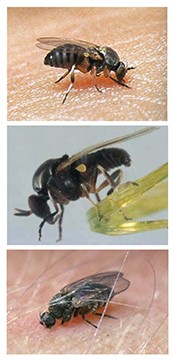Buffalo gnats are back. This time of year in central Illinois, many people are experiencing large red welts around their face and neck as a result of bites from these insects. Commonly called buffalo gnats, these annoying insects are part of the Simuliidae family of black flies. To find out more, we contacted Dr. Chris Dietrich at the Illinois Natural History Survey, which is part of the Prairie Research Institute at the University of Illinois at Urbana Champaign. Dietrich is Principal Research Scientist, Curator of Insects and Illinois State Entomologist with over 30 years of research experience.
There are more than 250 species of black flies in the United States, but only about a dozen are known to occur in Illinois, and few attack humans. They are related to “no-see-ums,” which are smaller and equally annoying.
Dietrich explains that it is the female of the species that bites, as females generally require a blood meal before they can produce viable eggs. Biting flies are attracted to carbon dioxide and body heat. When biting, the female flies inject saliva into the wound that acts as an anticoagulant, allowing blood to flow more freely from the wound. Other components of the saliva may cause a mild allergic reaction. Individuals react with varying levels of severity depending on their own allergies and immune systems. In our area, bites from the insects are not known to transmit diseases. Some individuals with many bites have reported flu-like symptoms, but this is likely a direct reaction to toxins in the saliva rather than any disease agents. Secondary infections may result from scratching the bites.
Ironically, improved stream restoration efforts have also improved conditions for black flies. The flies breed in streams, and females prefer to lay their eggs in streams that flow rapidly, have high oxygen content and are relatively cool and clear. Wildlife are their preferred hosts, and increases in wildlife populations may also contribute to higher populations of the flies.
Adult females usually lay their eggs in masses on partially submerged objects in streams. Larvae hatch and attach themselves to rocks or partially submerged objects and filter organic debris from the water. Adults emerge and are usually active from late spring to mid-summer.
Black flies breed in streams and can be prevalent, even if a stream is a few miles away. The best way to avoid being bitten is to stay indoors during early morning and dusk, which are the hours of peak activity, and wear long sleeves and pants with zippers rather than buttons. DEET is probably the most effective insect repellent.
Generally, black flies complete a single generation per year in our area. They should mostly disappear by mid-July, which will be a welcome relief.
During her long career in state government, Karen Ackerman Witter had many opportunities to work with scientists at the Illinois Scientific Surveys. Now part of the Prairie Research Institute at the University of Illinois, the Surveys are a go-to source of information about Illinois’ biological, geological, cultural and water resources.























